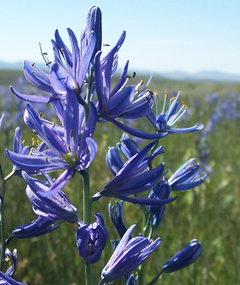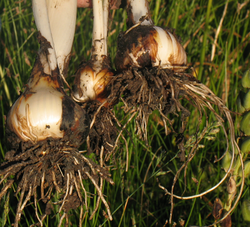 Camassia quamash, Quamash Camassia quamash, Quamash We can think of at least 180 great forest garden & perennial crops for cold climate Sweden. Want to hear about them? Over the course of the next year we will profile 5 a week on the blog. Perennial plants and crops offer a low energy, oil & resource input based foundation for future-proof agricultures. By default if an agriculture is to be called regenerative the bottom line is that it must be soil building, not soil depleting. Relentless deep tillage & poor soil husbandry (wifery?!) contributes to the majority of the 24 billion tons of topsoil lost every year on planet water. We are going to be focused on holistic polyculture grazing and perennial production at ridgedale over most of the site as this represents the most effective way to restore our degraded landscape, produce high value produce and ensure the future resource base we are managing holistically for in our decision making.  Genus Camassia Species quamash Common Name Quamash, Camas Form herb Habit clumping Origin North America Light sun Moisture wet to mesic Edible bulbs Quamash is native to western North America in large areas of southern Canada and the northwestern United States, from British Columbia and Alberta to California and east from Washington state to Montana and Wyoming. The bulb can be raw or cooked. Growing up to 5cm in diameter, it has a mild, starchy flavor when eaten raw, but a gummy texture that some find unpleasant. When cooked, however, it develops a delicious sweet flavor somewhat like sweet chestnuts, and is a highly nutritious food. Excellent when slow baked, it can also be dried and made into a powder which can be used as a thickener in stews or mixed with cereal flours when making bread, cakes etc. The bulbs can be boiled down to make a molasses, this was used on festival occasions by various Indian tribes. The bulbs can be harvested at any time of the year, but are probably best in early summer when the seeds are ripe. One report says that the bulbs contain inulin (a starch that cannot be digested by humans) but that this breaks down when the bulb is cooked slowly to form the sugar fructose which is sweet and easily digested. Quamash bulbs were a staple food of the N. American Indians. The tribes would move to the Quamash fields in the early autumn and, whilst some people harvested the bulbs, others would dig a pit, line it with boulders then fill it with wood and set fire to it. The fire would heat the boulders and the harvested bulbs would then be placed in the pit and the whole thing covered with earth and the bulbs left to cook slowly for 2 days. The pit would then be opened and the Indians would feast on the bulbs until they could no longer fit any more in their stomachs. Whatever was left would be dried and stored for winter use. A decoction of the roots has been used to induce labour. An infusion of the leaves has been used to treat vaginal bleeding after birth and to help expel the placenta. The bulbs were harvested and pit-roasted or boiled by women of the Nez Perce, Cree, and Blackfoot tribes. It also provided a valuable food source for the members of the Lewis and Clark expedition (1804–1806). OUR FRIENDS AT PFAF HAVE AN AMAZING DATABASE OF SPECIES (UK BASED);
0 Comments
Leave a Reply. |
Details
Like us on FB Below for regular updatesStay up to date with customized updates you want to receive
Upcoming coursesArchives
December 2016
Categories
All
|

 RSS Feed
RSS Feed